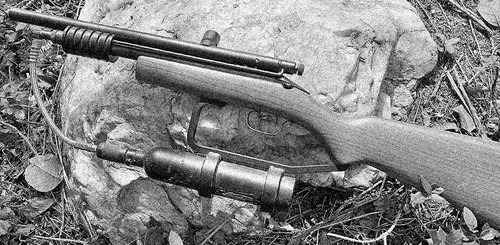Evolution of Paintball Air Sources
Posted by John Amodea & Josh Silverman on 17th Sep 2020
The Evolution of Paintball CO2 & Compressed Air
Paintball air sources have come a long way since the first game in 1981!
The first game of paintball that was played in 1981 is legendary. Each of the 12 players were equipped with a pair of shop goggles, 20 paintballs, a map of the playing field, a compass, several C02 cartridges and armed with a Nelspot 007—a paint marking gun used to mark cattle, sheep and livestock—as well as trees for excavation. The C02 cartridge-powered Nelspot was a very basic marker in that it held only 10 paintballs in a tubular magazine, had no cocking handle or pump arm (the paintball gun was single-shot bolt action) and used 12-gram C02 cartridges (sometimes called “powerlets”) instead of the larger C02 tanks or compressed air systems that would come later.
From 1981 to 1985 paintball players had two choices of paintball guns to use—the Nelspot 007 and the PMI PGP, which was introduced in 1983. But for the first four years of the game, 12gram C02 cartridges were the only power source for paintball—until 1985. Gramps and Grizzly, also known as Lou “Gramps” Grubb and Mike “Grizzly” Grubb, a father and son team from southern California introduced the first “constant air” systems for paintball. Constant air systems consisted of a larger tank (seven, ten and twelve-ounce capacity back then) and a valve to turn them on. With an air capacity measured in ounces instead of grams, paintball guns could now shoot hundreds of rounds before their air tanks needing refilling, as opposed to the 10-12 shots you would get from a 12-gram C02 cartridge, which always seemed to need changing at the most inopportune times during a paintball gunfight. This was a literal game-changer.
As the 1980s came to an end larger C02 tanks, 20 and 24-ounce sizes, were readily available. But through the late 1980s and into the start of the 1990s paintball guns were becoming much more high-tech and a better air source was needed. C02 is not a stable gas in that it can change from gas to liquid depending on the ambient temperature and this made the more hi-tech guns susceptible to problems. Early semiautomatic paintball guns like the 68 Automag, Minimag and Autococker shot much less consistently when liquid C02 entered the gun’s valve. Some paintball guns ran on pure liquid CO2 while others preferred the gaseous form, and the change between the two that often occurred on the field during play caused velocity spikes, ball breakage and other issues.


In 1991 that all began to change when Tom Kaye of Airgun Designs introduced the first Nitrogen systems for paintball guns. Nitrogen is a stable gas that for paintball applications cannot turn to liquid—and this is exactly what was needed for paintball gun technologies to advance. Guns like the Tippmann SMG60, Tippmann SL-68, Tippmann 68 Special and the Icon and Mega-Z models and a handful of other more low-tech semi-automatic paintball guns shot liquid C02 fine—but the high-end markers and the coming parade of electronic guns functioned on gas only. Other paintball guns in the low-to-mid-level like the Spyder line needed gas CO2 to operate at their best. Although Tom Kaye’s Airgun Designs never released commercial nitrogen systems to the paintball community, they passed their technology on to Dan Colby’s Air America—and they refined the technology year by year with air systems like the Bob Long air system, the Fred Schultz air system, the Air America Raptor and the Air America Apocalypse.
By the mid-1990s nitrogen was replaced by compressed air. The air we are all breathing is 78 percent nitrogen and 22 percent of other gasses. Compressing the air around us essentially has the same properties as nitrogen—without the heavy, bulky nitrogen filling systems. Instead, high-tech air compressors could produce 3000 PSI (pounds per square inch) tank fills which would be regulated at the gun down to 800psi or so to fire the paintball guns. Within a few years 4500 PSI systems were made available, allowing paintball compressed air systems to have the same or even greater firing capacity than the largest C02 tanks—all in a much more stable gas providing much more consistent velocity shot-to-shot, in any weather conditions. Paintball compressed air systems are now available in both 3000 and 4500 PSI capacities, with a variety of tank sizes to fit the needs and playing styles of every type of player.
Players today have the advantage of using high-tech markers, with high-tech air systems, electronic loaders, barrels sized to their exact batch of paintballs—and accessories and add-ons to fit their style of play. While the evolution of paintball gear is probably not complete, we have everything needed to compete at the highest levels. The game of paintball has never been more technologically advanced!
